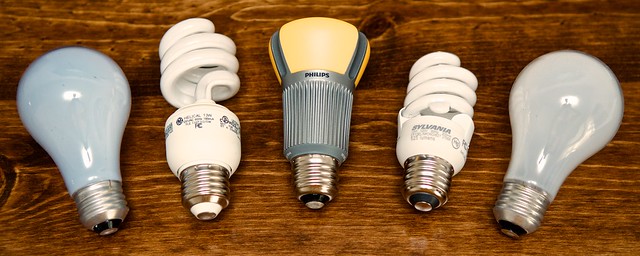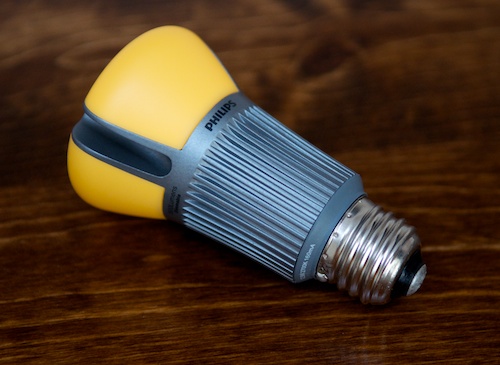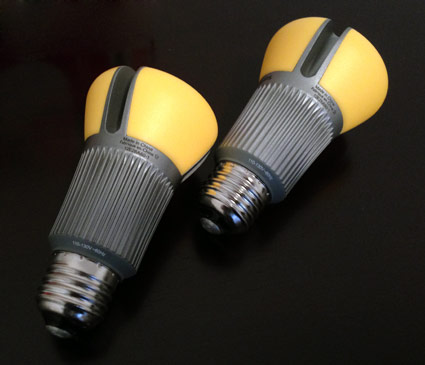tl;dr: The best value for a 60w replacement LED light bulb on the market, but doesn't dim very well. LED lighting still has room for improvement.

Left to right: 100W incandescent bulb, old style CFL, Philips AmbientLED, new 'micro-mini CFL', and a 43W halogen bulb.
CFLs and the Current State of Affairs
In the past few years, I've been experimenting with different efficient light bulbs. When CFLs started becoming available, I bought a few 60w and 100w-equivalent bulbs, but until about 2010, most of the bulbs had a garish, headache-inducing tint that made them unsuitable for many purposes, and also took a while to become bright (meaning there was a minute or two where the room would only be dimly lit).
Recently, CFLs (especially my current favorite, the 23W/100W-equivalent Sylvania Micro Mini CFL) have become much better, offering a pleasant soft white color (very closely matching standard incandescent bulbs), fast warm-up times, and smaller footprints (so they fit in practically any fixture).
However, CFLs have three major downsides:
- Mercury is used in the bulb, meaning they're not great for the environment.
- The good ones cost much more than incandescent or halogen equivalents (typically $5-6/bulb), and only last a little longer.
- Most CFLs emit a small amount of UV radiation, which can be damaging to skin (however, this is mitigated by placing the bulb in a glass enclosure, or in a lamp with a shade).
Sticking with incandescent or halogen light bulbs is out of the question for me because they use so much power—in one bathroom, there's a fixture with 7 bulbs; using standard bulbs, that would equal at least 400W. Using CFLs, I am currently consuming 91W. Since I use CFLs everywhere in the house (and turn out lights in unoccupied rooms), I only use about 1/5 of the power I would normally use for lighting. That translates into a much lower electric bill!
The LED Promise
LED light bulbs have been on the horizon for a few years, and only recently have become viable replacements for standard incandescent bulbs or newer CFLs. LED technology promises:
- Lower wattages (less energy) for equivalent light output (lumens)
- Better color rendition/consistency
- More creative bulb designs (especially for specialized light locations, like under counters).
- Longevity for individual bulbs. Decades, not years, is the measurement.
However, my earliest experiences with LED lighting left me wanting. There were manifold problems:
- Bulbs were barely brighter than a 10-20W incandescent.
- Color was blue, or at least blueish (definitely not white, or even approaching 'soft light').
- bulbs were strange shapes, and looked ugly. No way they'd go in a fixture where you see the bulbs.
To top that off, these terrible bulbs were still at least $10-20 each!
Philips seems set to change all of this with their latest LED light bulbs—the Endura LED and Ambient LED light bulbs finally tempt me to replace bulbs with LED bulbs!
Philips Ambient LED

I purchased two Ambient LED bulbs from a local home center for about $24 a pop (you can buy them on Amazon.com even cheaper—$22.25/bulb, as of this writing). After spending about five minutes getting the things out of the plastic and cardboard packaging, I put them into a ceiling light fixture on a Lutron 600W dimmer switch, and then into some standard floor lamps on a switched outlet. Here are my notes about the different aspects of the bulb:
Build Quality
These light bulbs are built very well. Compared to most CFLs and incandescent bulbs, these lights feel like tanks. They're weighty (most of the bottom is a metal heat sink), and the yellow light filter panels over the LEDs themselves are made of hard plastic. I'd imagine these could survive a drop or two, but I'm not going to test that myself!
Of all the LED bulbs I've used, these feel by far the most durable. And they don't look half-bad. A bit odd, with such a large heat sink, but not too space-age or ugly. I wouldn't put them in an open fixture, and definitely not in an outside fixture (to prevent theft!), but any lamp or enclosed fixture is fine for these.
You may be wondering why, if these bulbs are so efficient, they require a substantial metal heat sink. Well, even LEDs can't translate all their power into light; ~70% of the energy that goes into an LED bulb like this one from Philips is converted to heat. That heat has to go somewhere, otherwise the LED itself would not work very well (unlike halogen or incandescent bulbs, which create mostly heat anyways, and can tolerate very hot temperatures). Thus, a heat sink transfers the heat away from the LED. (Thus, it's important that you consider airflow around the LED bulb when you install it; a sealed light fixture might not be a good location for an LED bulb yet.
Light quality and output
CFLs were often known (until the past few years) for emitting a garish yellow or purple light. LED bulbs (until the past year or so) were known for emitting a ghastly blueish light, or being otherwise on the cool end of the spectrum—far removed from the 'warmer' glow (more on the yellow/red end of the spectrum) of typical filament-burning bulbs.
These Philips bulbs have a very pleasant hue to them—2700 Kelvin, according to the specifications—and match general incandescent or halogen lighting pretty well.
To my eye, they are very close to a normal 60W incandescent or an equivalent CFL. Maybe a touch less bright, but it's only noticable if you have two lights within a foot of each other.
Because the light is concentrated in the three yellow filters on the end of the bulb, though, the light is very bright in that area—don't stare directly into the bulb! The filters dissipate the light very evenly, though if you have no lampshade or other diffuser, you can notice a slight line of less light in the three areas where the heatsink creates a gap between the filters.
Definitely not a major mark against the bulbs, but it is annoying considering every other style of bulb puts out even light in all directions except towards the base.
Dimmability
These lights are specifically advertised as being able to work with incandescent dimmer switches, but I found that to be a bit of a stretch. Yes, they do dim a bit, but no, they don't work nearly as well as a dimmer.
I'd put these bulbs on par with "dimmable" CFLs—that is to say, not very. On my Lutron dimmer, I have to turn it up halfway to get the bulb to come on, and the bulb comes on almost at full brightness. You can dim the bulb down about halfway from there, but after that, the bulb just turns off. Then you have to go almost full-brightness again.
Definitely not suitable for a child's room or somewhere you need subtle dimmability. Plus, some of the bulb's efficiency is reduced when it's dimmed, especially since the electronic circuits in LED bulbs have to do extra work to translate the AC power into LED light.
Other notes

Reports of noise (a very slight buzz) from these bulbs seem to be sporadic. One of the two bulbs I bought buzzes a very slight amount at all times, and more so if it's being dimmed. However, I only notice the sound if I'm within a foot or two of the bulb.
Also, the bulbs take about 1/4 second to come on after you flick the light switch. Not a big deal, but it takes a few times using the lights to get used to it (especially if you're converting from instant-on, instant-brightness incandescent bulbs).
LED bulbs are here to stay
I'm very pleased with these bulbs so far, and judging by the fact that every year sees a new array of bulbs to choose from, I'll be able to pick up equivalent bulbs for half the cost next year. These are the first readily available A19-style LED lights I've been happy with, and were the price a little lower, I'd replace more of my bulbs with these without a thought.
One thing's for sure: with the array of small problems CFLs cause, and the energy-wasting traits of incandescent and halogen bulbs, the LED bulb market will do nothing but grow for the next few years, especially as prices drop and more manufacturers match the quality of these Philips bulbs.
Buy the Philips 12.5W Dimmable LED Light Bulb on Amazon for about $25.